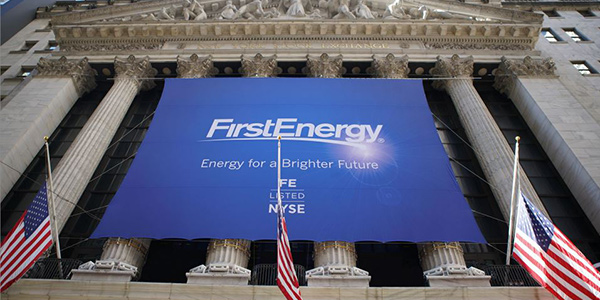
During a first-quarter earnings call Friday, the company said weather-adjusted load in its territories was down by almost 6% from mid-March to mid-April compared with last year.
Smart meter data from Pennsylvania showed residential loads up by 6% because of Gov. Tom Wolf’s stay-at-home order, while commercial and industrial load is down almost 13% compared to the company’s prior four-year average.
CEO Chuck Jones said the company’s rate structure and scale — with operations across 65,000 square miles in five states — will cushion it from the impact of the economic slowdown.
“We believe our distribution and transmission investments will continue to provide stable and predictable earnings,” Jones said. “As the situation continues to develop, the diversity and scale of our operations gives us the flexibility to shift our investments if needed and continue deploying capital throughout the system.”
Almost two-thirds of the company’s base distribution revenues are from higher-margin residential customers, with 28% from commercial and 7% from industrial customers, which are lower margin. About 80% of commercial and 90% of industrial distribution revenue is from customer and demand charges, not energy consumption.
One-fifth of its retail load — in Ohio — is decoupled, insulating the company from revenue losses because of energy efficiency and peak demand reductions. “This mix partially insulates FirstEnergy from recessions,” CFO Steve Strah said.
Protecting the Workforce
The company has increased cleaning and disinfecting measures at its locations and has 7,000 employees — more than half its workforce — working remotely, including its call center employees.
Workers unable to work remotely have been issued surgical masks, thermometers and other protective equipment and are reporting to locations that permit social distancing.
“We have positioned crews so they are working with the same small group of people each day on what we call pods. They’re consistently using the same vehicle and the same equipment to limit exposure. And we are managing our work to minimize potential exposure with the public,” Jones said.
The company has reported nine COVID-19 cases among its 13,000 employees. “One of those cases in New Jersey unfortunately resulted in a death,” Jones said. “But we’ve had zero cases where the disease has been transferred at work.”
Results
The company reported first-quarter 2020 GAAP earnings of $74 million ($0.14/share) on $2.7 billion in revenue, down from $315 million ($0.59/share) on revenue of $2.9 billion a year earlier. Operating (non-GAAP) earnings for the first quarter were 66 cents/share versus 67 cents/share in 2019.
Strah said 2020 GAAP results included a $318 million non-cash mark-to-market adjustment on the company’s pension and other post-employment benefit plans that it was required to recognize when its former merchant company, FirstEnergy Solutions, emerged from bankruptcy at the end of February. FES is now an unaffiliated independent company, Energy Harbor.
“In February, we used the proceeds from our senior note issuance, together with cash on hand, to fund the final settlement payment of $853 million to Energy Harbor upon their emergence,” Strah added.
The company affirmed its 2020 earnings guidance of $2.40 to $2.60/share and its expected compound annual growth rates (CAGR) of 6 to 8% through 2021 and 5 to 7% through 2023.
Capital Expenditures and Supply Chain
Jones said that much of the company’s guidance in its CAGR is driven by capital expenditures. “We don’t see any supply chain interruptions that we’re worried about right now. And that includes the workforce supply chain, because most of the significant capital investment that we’re making is being done with a contracted workforce that we lined up many, many years ago,” he said.
The company’s Buy America strategy, implemented about four years ago, has the company purchasing more than 80% of its supplies domestically, Jones added. “When you put that all together, I’m confident that that there’s not going to be any material swing in weather-adjusted revenues that are going to take us off track from delivering on our guidance … or I wouldn’t have reaffirmed guidance.”
Jones noted that the company has more than $2 billion in operations and maintenance expenses. “If we need to get a little more diligent at O&M discipline to offset some of what might be happening on the meter side of things, we’ll do that,” he said. “We can work to deliver on our commitments.”
Analyst Stephen Byrd of Morgan Stanley asked whether the company might have to slow its capital expenditures next year to reduce costs for its customers if the economic recovery is slow. “Is that viewed as … critical work that needs to be done? Or is there any consideration of customer ability to pay?” he asked.
“The impact on customers is always something that we’re very thoughtful about as we make these investments,” Jones responded. “But I do believe these investments are investments that are needed. The transmission and distribution infrastructure we have at FirstEnergy is old. It’s in some cases in need of repair and modernization.”
Bad Debts?
Jones said he wasn’t concerned about cash flow problems resulting from the company’s announcement last month that its 10 utility companies had temporarily discontinued power shutoffs for customers who are past due on their electric bills.
He thanked the Maryland Public Service Commission for issuing an order allowing utilities to defer for future recovery of prudent, incremental pandemic-related costs. The company can also recover incremental uncollectible expenses through existing riders in Ohio and New Jersey, he said.
“I’ve been in this business for 40 years; I don’t think it’s fair to assume that every customer who can’t pay their bill today is going to end up being a bad debt,” he said. “My experience is customers want to pay their bills; they don’t want a black mark on their credit history. And as long as we’re flexible and work with them the right way, we can generally get to where we don’t end up writing off a lot of what’s going to get backed up here today.”
Earnings transcript courtesy of Seeking Alpha.





